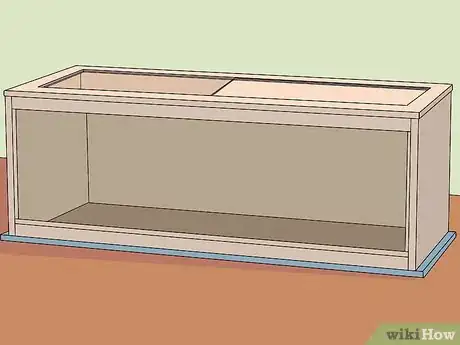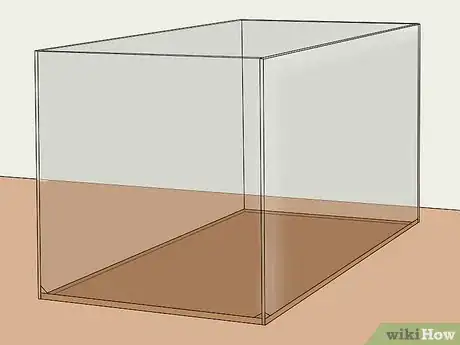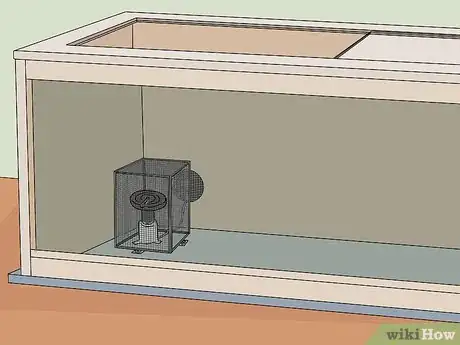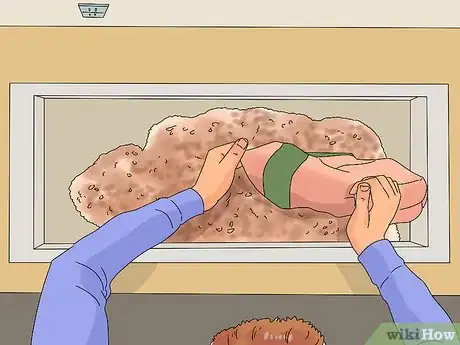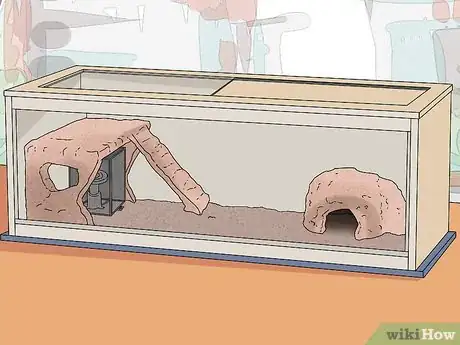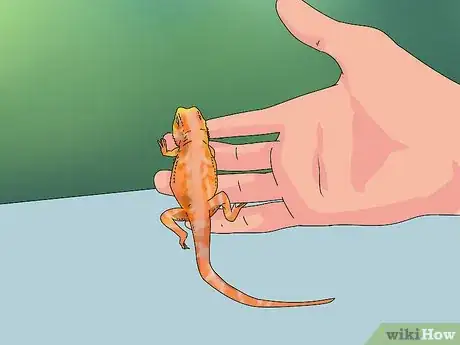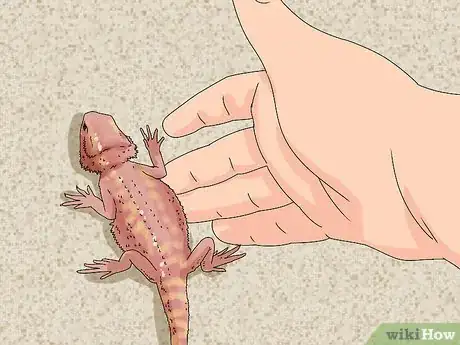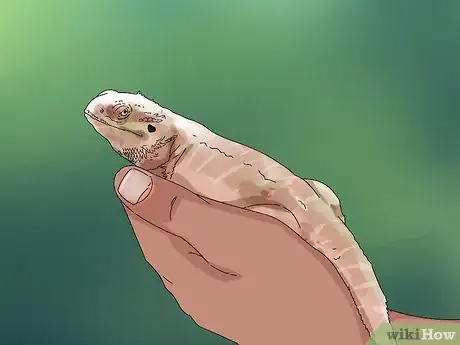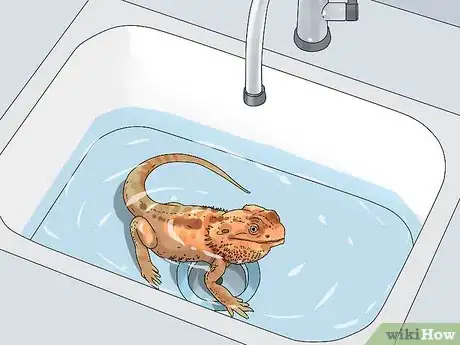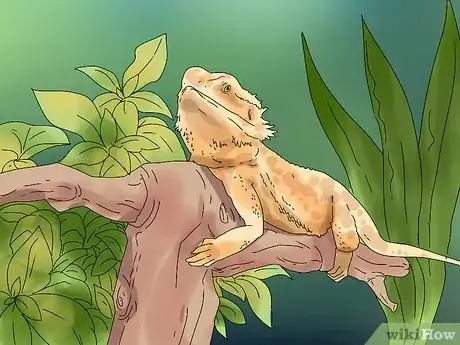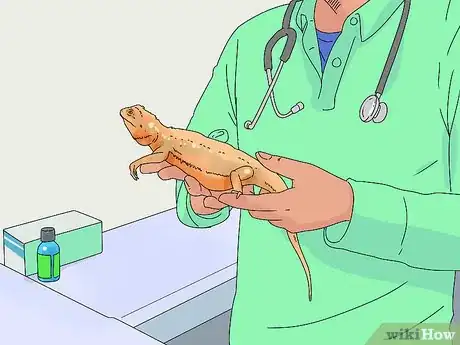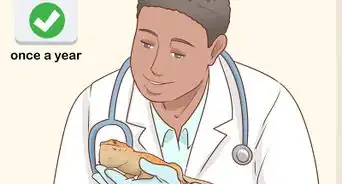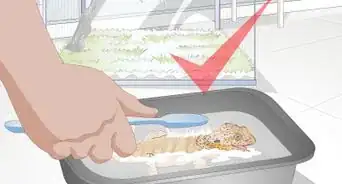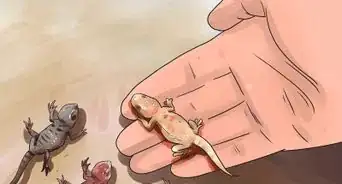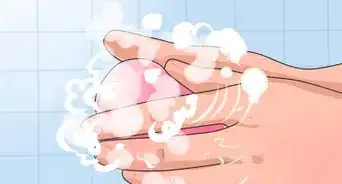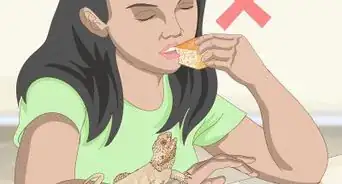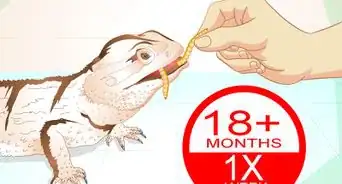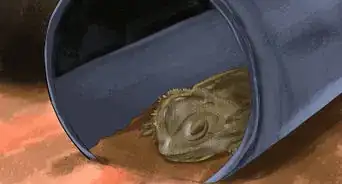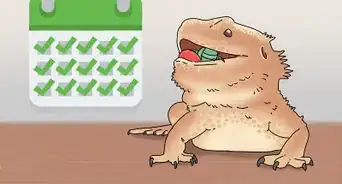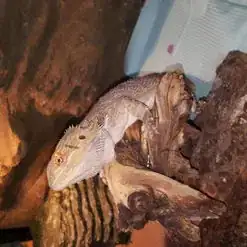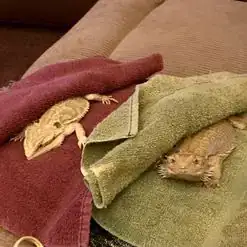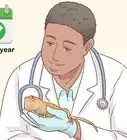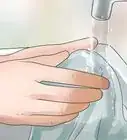This article was co-authored by Pippa Elliott, MRCVS. Dr. Elliott, BVMS, MRCVS is a veterinarian with over 30 years of experience in veterinary surgery and companion animal practice. She graduated from the University of Glasgow in 1987 with a degree in veterinary medicine and surgery. She has worked at the same animal clinic in her hometown for over 20 years.
wikiHow marks an article as reader-approved once it receives enough positive feedback. This article received 23 testimonials and 87% of readers who voted found it helpful, earning it our reader-approved status.
This article has been viewed 358,191 times.
When you own a bearded dragon, it is natural to want to love your pet. Your dragon also can have affection for you if you take care of him. Learn how to hold him appropriately, bathe, and house him. By providing a good and safe home for your pet, you show your love.
Things You Should Know
- Provide a spacious, high-quality habitat with non-toxic substrate, lounging furniture, and hiding spots.
- Pick up your bearded dragon often and pet it whenever it seems agitated or stressed.
- Try feeding your bearded dragon by hand occasionally to build a stronger bond.
Steps
Providing a Good Home
-
1Purchase a high quality vivarium. A vivarium is a wooden tank with a glass front. It should have a tight lid and smooth sides to prevent the dragon from hurting his nose. Look for a vivarium that will be easy to clean. Vivariums should have a polyurethane or waterproof sealing. You should make sure the joints are caulked as well.[1]
- If you waterproof a vivarium yourself, be sure to allow the vivarium to dry for a week before putting your dragon in his home.[2]
- Make sure your dragon has enough space to run around, climb, and sit on branches.
- Clean your pet’s habitat thoroughly regularly with a 10:1 mixture of water to bleach.[3] Remove any vegetables that he does not eat within four hours. Remove uneaten insects at the day’s end.[4]
-
2Use an aquarium. You can also purchase an aquarium for your dragon. Baby dragons can live in a 10–15 gallon (37.9–56.8 L) aquarium, while adults need a larger 55-60 gallon space.[5] Aquariums are a better short-term solution because it is difficult to regulate the temperature in them.Advertisement
-
3Provide a vivarium and a heater. Wooden vivariums encapsulate heat better than glass or metal does. Aim to provide a less warm area (30 degrees Celsius/86 degrees Fahrenheit) and a warmer section (45 degrees Celsius/113 degrees Fahrenheit). The vivarium should be no smaller than 48 x 24 x 24 inches (61 cm). Make sure your vivarium has air vents, minimally one per square foot. The vent should be on the upper part of the back wall rather than on the lower section. See Care for Bearded Dragons for additional instructions on how to set up your pet’s habitat and vivarium.
- You can purchase a vivarium or make your own using DIY kits, such as Vivexotic.
-
4Install a good substrate. A substrate is the material that fills the bottom of the vivarium. Your pet will dig into the substrate. Aim for a substrate that looks natural and makes your dragon feel at home. The substrate should also be absorbent. Because your dragon might eat parts of it unintentionally, try to find substrate that is non-toxic and safely digestible. You can utilize smooth newspapers, indoor or outdoor carpet, brown paper, AstroTurf.[6] .
- Do not use wood chips or shavings, gravel, cat litter, sand, or soil with pesticides, vermiculite, fertilizers, or surfactants for your substrate[7]
-
5Provide appropriate furniture. Include branches for climbing. A reptile hammock is also fun for your pet and available at pet stores. Equip your dragon's space with a "reptile hide," which is an enclosed area in which your dragon can hide from you. Your dragon also will use this space for long periods of sleep. Place a "basking platform" in the habitat as well. This can be a rock or another surface within six to eight inches of the basking light source. Here a dragon can warm himself.[8]
- Be sure to strip all bark from natural wood branches so that your dragon does not eat the wood. Clean all branches prior to use.[9]
Holding Your Bearded Dragon
-
1Know good practices. Dragons actually like to be held. Wait three to four days after the dragon’s arrival to start holding him. Wash your hands before and after handling the pet. Begin by holding him for short periods multiple times a day. This helps build trust slowly.
- When holding your dragon, strive to have a quiet setting.
- Babies, young children, women who are or might be pregnant, the elderly, or people with weakened immune systems should be careful about touching the dragon or being near its home.[10] Salmonella infections can occur. Consult a doctor if you or your child belongs to one of these populations before allowing contact with the reptile.
- See Hold a Bearded Dragon for thorough tips.
-
2Pick up the dragon. Gather your dragon from underneath his body in a slow, yet self-assured, scooping motion. Support his whole body plus his legs and tail. Do not hold or pull your dragon by his tail. It can come off![11]
-
3Calm your dragon. It is important to tame your dragon from the beginning. If your dragon appears aggressive (his “beard” will darken), hold him tightly (not too tightly) with both of your hands and pet him. If your pet appears particularly agitated, release him for a short moment and then try holding him again until he calms himself. Training your dragon to be held and calm can take a number of months but it is vital to creating a good relationship with your dragon.
Bonding With Your Dragon Through Care
-
1Feed your dragon by hand. One way to bond with your dragon is to give him his food directly. You should do this occasionally but not so often that your dragon becomes reliant upon you. Instinctually, dragons hunt for their food so you should still give your dragon his food in a bowl most of the time. Place the food on the tip of your fingers. Your dragon will use his tongue to take the food from you.
- Bearded dragons eat vegetables, living insects like crickets, waxworms, or mealworms, or bearded dragon foods available for purchase at pet shops.[12] Safe vegetables include squash, endive, turnip greens, or collard greens. Dragons also can eat apples, strawberries, and melons.[13]
- Do not feed your pet spinach, avocado, lettuce, or wild insects.[14]
- Implement a regular feeding plan. Whether feeding by hand or putting the food in your dragon’s home, your dragon will anticipate feeding time. He then will associate a positive experience with you!
- You should feed your young dragon once daily and your adults once per day or every second day.[15] Juvenile dragons require a mainly live food diet. Beardies are able to transition onto a vegetarian diet as they mature.
- It is possible your dragon might think your fingers are food. Be careful when feeding him!
-
2Bathe your bearded dragon. By giving your lizard a bath, you will help him stay hydrated. Dragons absorb water through their pores. This is particularly important because dragons do not love to drink form a water bowl. To bathe your dragon, fill a tub, or other clean container with warm water. Do not use the sink or bathtub for lizards carry the bacteria salmonella and could affect the sink or bathtub (try to reach 34.5-35.5 degrees Celsius/94-96 degrees Fahrenheit). Your dragon might enjoy this activity and again associate pleasure with you!
-
3Aim for a stress-free environment. In order for your dragon to be happy, you should try to reduce his stress levels. High stress can lead to aggression. When your dragon sleeps, keep the noise levels in your house down. When your dragon decides to hide under something, this could signal that he wants to be alone. Try to respond appropriately to your dragon’s behavior and avoid disturbances unless there is a pressing need.
- It’s okay to let your dragon roam a bit outside his habitat. Just be sure to keep him from the kitchen or other rooms where you eat or prepare food.
-
4Take your dragon to the veterinarian. Like any pet, bearded dragons should have yearly check-ups. Also, if you sense that your bearded dragon is acting differently than normal, schedule an appointment with the vet. Mites are a common issue that dragons face--they suck the reptile’s blood. Only a vet can determine, though, through testing whether your pet is truly ill.[18]
Expert Q&A
Did you know you can get expert answers for this article?
Unlock expert answers by supporting wikiHow
-
QuestionIs it okay to take my bearded dragon outside?
 Pippa Elliott, MRCVSDr. Elliott, BVMS, MRCVS is a veterinarian with over 30 years of experience in veterinary surgery and companion animal practice. She graduated from the University of Glasgow in 1987 with a degree in veterinary medicine and surgery. She has worked at the same animal clinic in her hometown for over 20 years.
Pippa Elliott, MRCVSDr. Elliott, BVMS, MRCVS is a veterinarian with over 30 years of experience in veterinary surgery and companion animal practice. She graduated from the University of Glasgow in 1987 with a degree in veterinary medicine and surgery. She has worked at the same animal clinic in her hometown for over 20 years.
Veterinarian Exposing a bearded dragon to natural sunlight is a great idea. However, it's best to do this on a warm or hot day, so that he is able to move around and doesn't panic because he's too cool to be mobile. Also, some beardies become fearful outside if they see birds circling overhead. If your dragon's beard starts to go black, bring him back inside.
Exposing a bearded dragon to natural sunlight is a great idea. However, it's best to do this on a warm or hot day, so that he is able to move around and doesn't panic because he's too cool to be mobile. Also, some beardies become fearful outside if they see birds circling overhead. If your dragon's beard starts to go black, bring him back inside. -
QuestionIs carrying my bearded dragon on my shoulder and letting her fall asleep on my chest a good way to bond with her?
 Pippa Elliott, MRCVSDr. Elliott, BVMS, MRCVS is a veterinarian with over 30 years of experience in veterinary surgery and companion animal practice. She graduated from the University of Glasgow in 1987 with a degree in veterinary medicine and surgery. She has worked at the same animal clinic in her hometown for over 20 years.
Pippa Elliott, MRCVSDr. Elliott, BVMS, MRCVS is a veterinarian with over 30 years of experience in veterinary surgery and companion animal practice. She graduated from the University of Glasgow in 1987 with a degree in veterinary medicine and surgery. She has worked at the same animal clinic in her hometown for over 20 years.
Veterinarian
-
QuestionWhy does a bearded dragon's beard puff up?
 Pippa Elliott, MRCVSDr. Elliott, BVMS, MRCVS is a veterinarian with over 30 years of experience in veterinary surgery and companion animal practice. She graduated from the University of Glasgow in 1987 with a degree in veterinary medicine and surgery. She has worked at the same animal clinic in her hometown for over 20 years.
Pippa Elliott, MRCVSDr. Elliott, BVMS, MRCVS is a veterinarian with over 30 years of experience in veterinary surgery and companion animal practice. She graduated from the University of Glasgow in 1987 with a degree in veterinary medicine and surgery. She has worked at the same animal clinic in her hometown for over 20 years.
Veterinarian
References
- ↑ http://www.peteducation.com/article.cfm?c=17+1796&aid=2730
- ↑ http://www.peteducation.com/article.cfm?c=17+1796&aid=2730
- ↑ http://www.peteducation.com/article.cfm?c=17+1796&aid=2730
- ↑ http://pets.petsmart.com/guides/bearded-dragons/_downloads/care-guide.pdf
- ↑ http://www.peteducation.com/article.cfm?c=17+1796&aid=2730
- ↑ http://www.peteducation.com/article.cfm?c=17+1796&aid=2730
- ↑ http://www.peteducation.com/article.cfm?c=17+1796&aid=2730
- ↑ http://www.thebeardeddragon.org/bearded-dragon-setup.php#accessories
- ↑ http://www.thebeardeddragon.org/bearded-dragon-care.php
- ↑ http://pets.petsmart.com/guides/bearded-dragons/_downloads/care-guide.pdf
- ↑ http://pets.petsmart.com/guides/bearded-dragons/_downloads/care-guide.pdf
- ↑ http://pets.petsmart.com/guides/bearded-dragons/feeding-your-beardie.shtml
- ↑ http://www.thebeardeddragon.org/bearded-dragon-care.php
- ↑ http://www.thebeardeddragon.org/bearded-dragon-care.php
- ↑ http://pets.petsmart.com/guides/bearded-dragons/feeding-your-beardie.shtml
- ↑ http://pets.petsmart.com/guides/bearded-dragons/_downloads/care-guide.pdf
- ↑ http://www.thebeardeddragon.org/bearded-dragon-care.php
- ↑ http://www.thebeardeddragon.org/bearded-dragon-health.php
About This Article
To build love with your bearded dragon, make sure to hold it gently in your hands for a few minutes each day in order to bond with it. Additionally, feed your dragon by hand occasionally, and bathe it every 4-8 days so it associates you with these happy, positive experiences. You should also try to provide your dragon with a low-stress environment, since high stress can lead to aggression in bearded dragons. For example, keep your house quiet when your dragon sleeps, and give your dragon alone time when it does things like hide under a rock. For more tips from our Veterinary reviewer, like how to provide your bearded dragon with a safe, comfortable home, read on!
